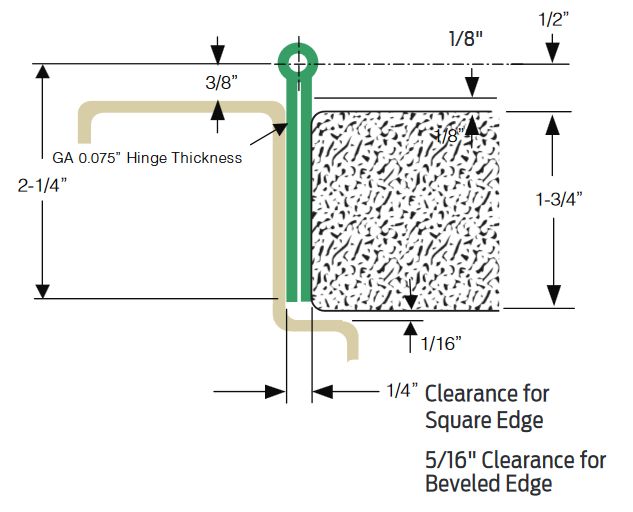I wish I had all the answers, but sometimes a question comes up that doesn’t have a black and white answer. At least, there isn’t a clear answer until a code change proposal goes through the looong process to attempt to modify the applicable code or standard. It can take years for a change to make it into a code or standard, and then it can be even more years before a state or local jurisdiction adopts that edition.
 Anyway…here’s one of those questions/issues that’s on the wish list for NFPA 80. Two paragraphs were added in the 2013 edition of NFPA 80 to address continuous hinges used on fire doors. These also appear in 80-2016 and 2019:
Anyway…here’s one of those questions/issues that’s on the wish list for NFPA 80. Two paragraphs were added in the 2013 edition of NFPA 80 to address continuous hinges used on fire doors. These also appear in 80-2016 and 2019:
6.4.3.1.6 The length of continuous hinges shall be within 1 in. (25 mm) of the height of the door leaves.
6.4.3.1.7 Continuous hinges shall be labeled and shall meet the requirements of ANSI/BHMA A156.26, American National Standard for Continuous Hinges.
I’ve seen these sections many times and never noticed a potential problem, until it came up twice in the last couple of weeks. The issue has to do with this section of NFPA 80:
6.3.1.7.1 The clearances between the top and vertical edges of the door and the frame, and the meeting edges of doors swinging in pairs, shall be 1⁄8 in. ± 1⁄16 in. (3.18 mm ± 1.59 mm) for steel doors and shall not exceed 1⁄8 in. (3.18 mm) for wood doors.
The maximum clearance between the vertical edge of the door and the frame is 1/8-inch for wood fire doors rated for more than 20 minutes, and 3/16-inch for steel fire doors and 20-minute doors in hollow metal frames. A full-mortise continuous hinge (the most common kind of continuous hinge) requires a clearance larger than this (+/- 5/16-inch) in order to accommodate the thickness of the two hinge leaves. AND…If the hinge is allowed to be 1 inch shorter than the door leaf, that leaves a gap – potentially 1 inch x 5/16-inch (+/-), which is not within the clearance limitations stated in NFPA 80.
Does that mean that a continuous hinge can’t be used on a fire door? NO – it doesn’t! If a continuous hinge has been successfully tested and is listed for use on a fire door assembly, the manufacturer can provide information for the AHJ, as covered in NFPA 80 section 1.4 – Equivalency. This test data and product information should be sufficient for the AHJ to determine that the product is acceptable for use on a fire door, even if the larger clearance dimension is not specifically addressed in NFPA 80. This also applies to other new, modified, or improved products which meet the intent of the standard.
You need to login or register to bookmark/favorite this content.





Never saw this as a problem… when the continuous hinge is properly “married” (attached with the 40 or so screws) to the door, the two become as one, in my humble opinion.
Another good article Lori!
Continuous hinges are a very popular remedy to close the gaps on clearances. However, as you stated, they must be Listed.
I have seen continuous hinge applications that also use fillers to close the gap further. Fillers void the continuous hinge listing.
In one case the installer needed an addition 3/4″and padded the continuous hinge / frame with aluminum fillers. You could see the fillers from the push side of the door. This was done by an installer / distributor that was “installing doors for 25 years”. I wanted to mention the name of company so bad but, you wouldn’t publish this reply!
Keep up the good work!
It seems to me that the paragraph 6.4.3.1.6 is stated incorrectly. I believe they meant to state ‘within 1″ of the door opening height’, not door leaves. A typical hinge for an 80″ door, for example, is 79″. Because the hinge completely fills the extra gap caused by the under sizing of the door to accommodate the fire rated hinge, it does not seem to be an issue to me as long as the lock/strike side has the correct margin. The larger margin is only reflected on paper when the door size and frame opening are compared. Once the door is installed, the hinge side margin is zero and the lock side would have to be within the acceptable margin allowed.
What about full surface continuous hinge? Can it be installed with through bolts on a wooden fire door?
Hi Michael –
That depends on the listings of the door manufacturer. It’s best to check directly with them.
– Lori